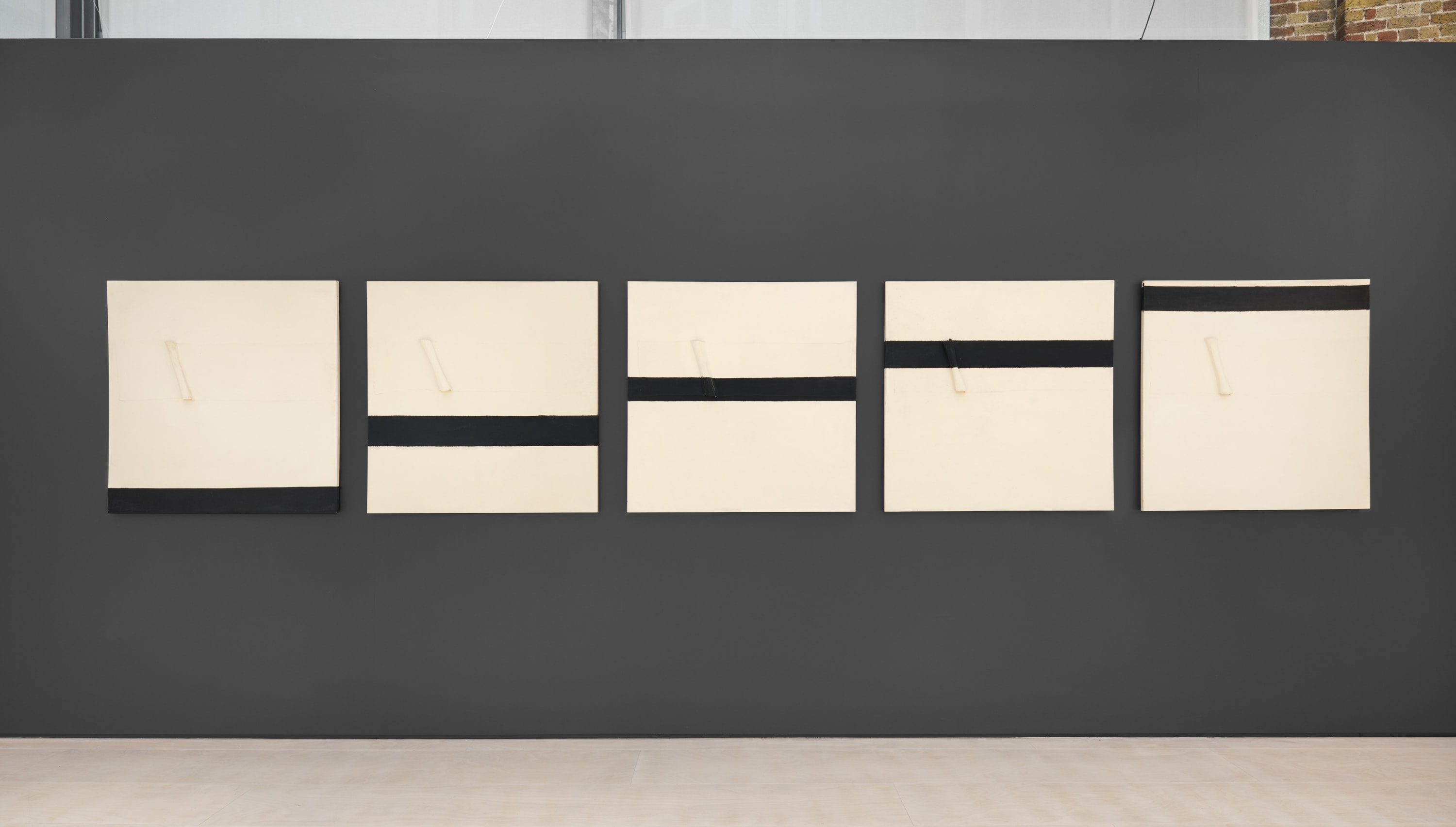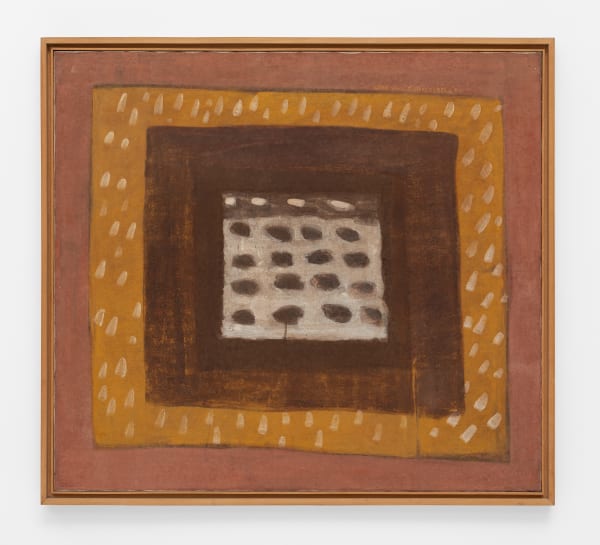-
Katie van Scherpenberg
Traces: 1968 - 2007
22 June – 28 July 2023
-
Cecilia Brunson Projects is delighted to present the second UK exhibition by Katie van Scherpenberg. Drawing together works produced in Brazil between 1960s-2000s, Traces gives unique focus to the depth of van Scherpenberg's environmental investigations. Her gestural, transmutational work offers a tender and thoughtful approach that counters the monumental land art practices unfolding concurrently in North America and Europe. The tenets of both painting and environmental thought are dismantled to a point of pure simplicity in works such as Jardim Vermelho [Red Garden] (1986), a landmark event in the history of Brazilian painting.
-
 Jardim Vermelho [Red Garden], 1986/2023, Series of four C-Type prints, Unframed: 33 x 50 cm (13 x 19 3/4 in) each, Framed: 33.5 x 51 cm (13 1/4 x 20 1/8 in) each, Overall dimensions: 71 x 107 cm (28 x 42 1/8 in) (variable), Edition 1 of 3 + 2 APs
Jardim Vermelho [Red Garden], 1986/2023, Series of four C-Type prints, Unframed: 33 x 50 cm (13 x 19 3/4 in) each, Framed: 33.5 x 51 cm (13 1/4 x 20 1/8 in) each, Overall dimensions: 71 x 107 cm (28 x 42 1/8 in) (variable), Edition 1 of 3 + 2 APs -
 Jardim Vermelho [Red Garden], 1986/2023, C-Type print, Unframed: 50 x 33 cm (19 3/4 x 13 in), Framed: 51.5 x 34.5 cm (20 1/4 x 13 5/8 in), Edition 1 of 3 + 2 APs
Jardim Vermelho [Red Garden], 1986/2023, C-Type print, Unframed: 50 x 33 cm (19 3/4 x 13 in), Framed: 51.5 x 34.5 cm (20 1/4 x 13 5/8 in), Edition 1 of 3 + 2 APs -
 A queda de Ícaro [The fall of Icarus], 1980, Signed & dated on reverse, Tempera and soot on five canvases, 100 x 100 cm (39 3/8 x 39 3/8 in) each, Overall dimensions: 100 x 552 cm (39 3/8 x 217 3/8 in) (variable)
A queda de Ícaro [The fall of Icarus], 1980, Signed & dated on reverse, Tempera and soot on five canvases, 100 x 100 cm (39 3/8 x 39 3/8 in) each, Overall dimensions: 100 x 552 cm (39 3/8 x 217 3/8 in) (variable) -
The exhibition also includes the 1980 work A queda de Ícaro [The fall of Icarus], a turning point in the painter's trajectory which finds cohesion between the national artistic language of geometric abstraction and van Scherpenberg's meditations on landscape. This abstract interpretation of the myth of Icarus is quite possibly van Scherpenberg's most significant work. By retelling the story of the boy who flew too close to the sun, the artist explores geometry, abstraction, materiality, and colour. With this story stripped to its most basic elements, the spectator can do nothing but observe the descent and track the movement through space. Five canvases convey a temporal sequence; as Icarus falls, our focus is on the moving horizon, which swallows his body and stretches on. A moment of human drama is dwarfed by the overwhelming expanse of nature, that must continue on its course, regardless. It is a work about hubris and about approximation to the unattainable. Gabriel Pérez-Barriero sees this work as foundational for the artist's perception of the 'relationship between the human body, nature, paint and indifference'. This piece was first shown in Sao Paulo alongside the work of Anna Maria Maiolino and Paulo Herkenhoff (at that stage an artist as well as critic).
-
-
Since the 1990s, van Scherpenberg has worked with her own body, recording her performances in video art and photography. In 2004, the artist returned to the home she had shared with her father in the Amazon, by then almost completely destroyed. Her father had died some three decades earlier in 1971 on the island where they lived and where this performance took place. The artist performed Esperando Papai (Waiting for Daddy) at dusk on the bank of the Rio Negro River (a major tributary of the Amazon River). The work manifests as a series of photographs, taken at intervals as the light of the sun fades. As the sky darkens, the artist’s lamp light gets brighter. The artist is seen sitting in the water facing out into the river until the last two images, where she walks towards the camera. In the final photograph, van Scherpenberg meets the viewer’s gaze. It is a work which is both confronting and deeply moving as a meditation on the artist’s past, her natural surroundings, and the passing of time.
A series of figurative drawings gain new meaning amongst these photograhic landscape works, as a dialogue emerges about the connections between life and relationships and the environments in which they unfold. Amongst van Scherpenberg’s sensitive drawings of human figures, including depictions of parental relationships, the photographs are imbued with an emotional weight unexpected in landscape photography.
-
-
-
 Miragem / Tempestade sobre o Amazonas [Storm over the Amazon], 2003, Signed & dated bottom left and on reverse, Pigments, copper leaf, encaustic on marine plywood and linen, 112 x 163 cm, 44 1/8 x 64 1/8 in
Miragem / Tempestade sobre o Amazonas [Storm over the Amazon], 2003, Signed & dated bottom left and on reverse, Pigments, copper leaf, encaustic on marine plywood and linen, 112 x 163 cm, 44 1/8 x 64 1/8 in -
Born in São Paulo in 1940, van Scherpenberg spent her youth between Brazil and Europe and studied art in Munich and Salzburg, before returning to Rio de Janeiro in 1964 and then settling on Ilha de Santana, a remote island in the Amazon delta. Working under the Brazilian dictatorship, when artists' supplies were scarce, drove her to look to the environment of the Amazon and research ways to make natural pigments, a pioneering project that drew upon a relationship to nature based on convivialism rather than extractivism, a major principle of ecofeminism.
Van Scherpenberg reintroduced the question of painting and of the viewer's position in her experimental works of the 1980s. Her work is immeasurably influenced by her time spent in the Amazon, her observations of its landscape and her particular notion of it as a living painting, carrying colour and a sense of continual evolution. In her gentle and fleeting actions in the landscape, she offers a point of reference for one of the most pressing themes challenging artists today. These works are testaments to the role of the Amazon as the source that feeds and sustains her practice.



![Katie van Scherpenberg Esperando Papai [Waiting for Daddy], 2004/2023 Series of 12 C-Type prints Unframed: 50 x 33 cm (19 3/4 x 13 in) each Framed: 51.3 x 34.8 cm (20 1/4 x 13 3/4 in) each Overall dimensions: 110 x 250 cm (43 1/4 x 98 3/8 in) (variable) Edition 1 of 3 + 2 APs](https://artlogic-res.cloudinary.com/w_600,c_limit,f_auto,fl_lossy,q_auto/artlogicstorage/cbprojects/images/view/a45f68d14b9ce8f2aa1935617298eee4j.jpg)
![Katie van Scherpenberg Menarca [Menarche], 2007 Single channel video with sound Duration: 4'04'](https://artlogic-res.cloudinary.com/w_600,c_limit,f_auto,fl_lossy,q_auto/artlogicstorage/cbprojects/images/view/f05c34a54d51f139266d05364be09299j.jpg)
![Katie van Scherpenberg Furo [Hole], 2001/2023 C-Type print Unframed: 50 x 48 cm (19 3/4 x 18 7/8 in) Framed: 64.5 x 57 cm (25 3/8 x 22 1/2 in) Edition 1 of 3 + 2 APs](https://artlogic-res.cloudinary.com/w_600,c_limit,f_auto,fl_lossy,q_auto/artlogicstorage/cbprojects/images/view/c13a2f90b1d1366eb231ef9dec271d8cj.jpg)


![Katie van Scherpenberg O abraço [The hug], 1980s Charcoal on paper Unframed: 30 x 21 cm (11 3/4 x 8 1/4) Framed: 42.5 x 34 cm (16 3/4 x 13 3/8 in)](https://artlogic-res.cloudinary.com/w_600,c_limit,f_auto,fl_lossy,q_auto/artlogicstorage/cbprojects/images/view/17921f6bd8751a8473246bd0ba963554j.jpg)


